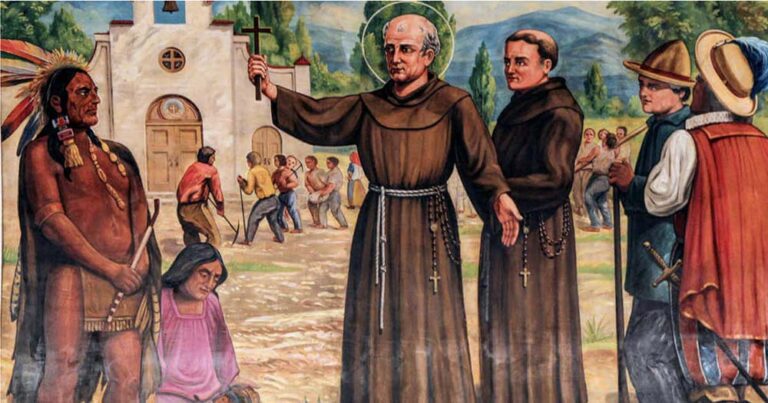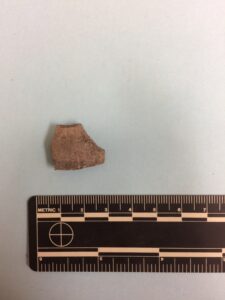
Almost all California historians will tell you the state’s wine industry was started by Spanish missionaries in the late 18th century because they needed wine for their religious services. Eventually, they would establish 21 missions from San Diego to Sonoma. These Franciscan fathers were led by Father Junipero Serra, who would, amid controversy, be canonized as a saint by the Catholic Church in 2015.
“In 1777, Father Junipero Serra wrote to the viceroy of Mexico and asked that grapevines be sent to California,” said Frances Dinkelspiel, author of Tangled Vines: Greed, Murder, Obsession and an Arsonist in the Vineyards of California. She quoted Father Serra as writing, “The lack of wine for mass is becoming unbearable.”
“Grapes were brought in May 1778 on board the supply ship San Antonio and were unloaded in what would one day be Orange County,” said Dinkelspiel. “They were planted at San Juan Capistrano. The first vintage from those grapes was probably 1782.”
The grapes were called mission grapes, and they flourished in the Orange County area. Even so, the Franciscans decided to concentrate their winemaking efforts at their missions across the state.
The area around the San Gabriel Mission soon produced the most wine in the state with about 170 acres planted and 35,000 gallons of wine a year produced. The next biggest wine producer was San Fernando, followed by Ventura and San Jose, according to Thomas Pinney, author of The City of Vines: A History of Wine in Los Angeles.
Working Conditions
“The Franciscan friars came to California with the intent of converting Native Americans to Christianity,” said Dinkelspiel, adding a lot of Native Americans agreed to be baptized not knowing what they were signing up for.

The Franciscans insulated the Native Americans and tightly controlled their daily lives. They separated the men and women and “made Natives work in the fields, regulated by a series of bells,” she said, explaining the church bells would signal when it was time to wake up, when it was time to start working in the fields, when it was time to eat and when it was time to sleep.
Many Native Americans became addicted to aguardiente, a type of brandy made from mission grapes that was 18% to 20% alcohol. They were not permitted to drink at the missions, so they would go to Calle de los Negros, a rough street in Los Angeles that was filled with brothels, saloons and gambling parlors, according to Dinkelspiel.
The Gold Rush caused a shortage of workers to plant and harvest grapes.
“When gold was discovered, most young men left for the gold fields, leaving very few people behind to grow food,” Dinkelspiel said. “So, vintners relied on the workforce that was available: Indians.”
The very first law passed by the new state of California in 1850 was intended to keep Native Americans in the vineyards.
“It was nicknamed the ‘Indian Indenture Act,’ and it was adopted to address the worker shortage caused by the Gold Rush,” said Dinkelspiel. “The law allowed any white man to identify a Native American as vagrant, lazy or drunk, which would permit a marshal or sheriff to arrest and fine him. Since most Native Americans could not pay the fines, a week’s worth of their labor would be auctioned off to the highest bidder, who would then pay the fines.”

Many of the businesses paid their workers in wine, she said. Since Native Americans had more difficulty processing alcohol, the sheriff would round them up. Most of them were put to work in the vineyards.
“They thought of them as savages,” she said about the mindset of those running the state. “They’re ‘inferior to us.’ It was indentured servitude.”
Early Native American Winemaking
While almost all wine historians will say California winemaking began with the missionaries’ need for wine, a recent discovery in Texas suggests the possibility Native Americans made wine before the European settlers arrived.
“I think it’s likely because wine is a highly soluble product,” said Crystal Dozier, Ph.D., assistant professor and archaeologist at Wichita State University.
The archaeological digs she conducted at three sites near Austin, Texas found ceramic remnants dating from 1300 to 1650 with the residue of two compounds, tartaric and succinic acids, which are both found in high concentrations in wine.
The area, which was inhabited by those believed to be ancestors of tribes such as the Lipan Apache, is known to have had grapes for many centuries.
“Texas is a great place to grow wild grapes,” said Dozier. “The early colonists were taken aback by how abundant the plants were.”
Historically, tribes in North America are known to have produced a variety of fermented drinks. Balché is a Mayan drink made from the bark of the balché tree and a small amount of honey. Pulque is a light agave wine produced by the Aztecs. Tribes in Southern Arizona and across the border in Northern Sonora produced saguaro cactus wine from the red fruit of the saguaro cactus. In Southern Mexico and Central America, Native Americans made coyol wine, an alcoholic beverage from the sap of coyol palms.
Virtually all tribes in North America had some fermented beverage that was reserved for special occasions when groups of people gathered, such as meetings of tribes for trade or other negotiations. Based on “the large ovens and big crockpot” and the amount of trash discovered during her dig, Dozier estimates “hundreds if not a thousand people” would often be at these events.
After Dozier published her findings, a similar study found what scientists believe is evidence of the earliest known wine drinking in the Americas on ceramic artifacts found on Isla de Mona, a small Caribbean island between the Dominican Republic and Puerto Rico. The findings were published in Archaeological and Anthropological Science: Reports.
“It’s not the only study that found wine,” said Dozier, adding the likeliness of the discovery of a different fruit (causing the tartaric and succinic acids residue) is unlikely. “There are less varieties of fruit produced there.”
It seems it would be easy for tribes in California to make wine from grapes, which were abundant in the state.
“If you put grape juice in a container, it will start fermenting based on temperature,” said Dozier. “All the yeast needed for fermentation can be on the skin of grapes. You start seeing fermentation at 12 hours. Wine should be produced in three days whether it gets a high enough fermentation to be what you consider wine.”
Or Maybe Not
“While there is evidence native Californians harvested and used local wild grapes (Vitis californica), from our understanding, the production of grape wine in California did not take place until the Spanish Mission period,” according to an archivist at the Autry Museum in Los Angeles.
Vitis californica has been abundant in California for centuries, but it is considered too bitter for winemaking. Instead, it has been used for other purposes such as making jelly.
Since Native American tribes often interacted with surrounding tribes, perhaps any winemaking knowledge the tribes in Texas may have had eventually found its way to California.
“I haven’t seen any evidence of California artifacts in the sites in Central Texas, and no California sites have Texas artifacts,” Dozier said.
This suggests California tribes would probably not have learned any possible winemaking techniques from the Native Americans in Texas, but that may never be known. No archaeological digs in the state have made this question a priority, according to Dozier.
“No one has looked for wine residue,” she said. “Also, some areas never produced ceramics.”







